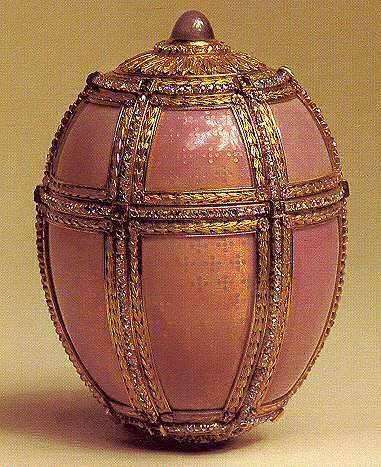Danish Palaces Faberge Egg
The Danish Palaces egg is one of the 52 authentic Faberge eggs made for the Russian imperial royal family. Peter Carl Faberge the master jeweler designed the eggs. It is the sixth egg of the series.
The history of this original Faberge egg is relatively easy to follow when compared to some of its sister eggs. And near-complete documented ownership all the way back to its creation. While the egg remains in good condition today. The original stand from the egg has been lost, resulting in a replacement being created.
Origins of The Danish Palaces Egg
Alexander III commissioned the creation of the egg to serve as a present to his wife on Easter of 1890. Danish Palaces is four inches in height, and 2.6 inches in width. It is made from pink-mauve enamel, multicolored gold, emeralds, star sapphires, diamonds, and crimson velvet lining.
The exterior consists of the pink-mauve enameled gold being divided up into twelve different sections. Six vertical lines and three horizontal lines serve as a divider to the panels of gold. The lines consist of rose-cut diamonds. There is an emerald placed at point that the lines cross. The egg is topped with a medallion of leaves placed around a cabochon star sapphire. The other end of the egg is decorated with more acanthus leaves.
When you open the egg, the egg reveals a 10-panel screen depicting Danish Palaces and Yachts. The frames of the panels are designed with tangent circles and have a multicolored gold wreathe at the apex. Each frame stands on Greek meander feet. All of the images depicted in the egg are signed by Konstantin Krijitski and dated as 1889.
The interior frames of the egg are created from multicolored gold. While the paintings are created from watercolor on mother or pearl. If there was an original stand with the egg, it has been lost. The stand seen with it now is a recent addition.
Who Created the Egg
Peter Carl Faberge commissioned the creation of the egg. Several years after he was appointed jeweler by special appointment to the Tsar. However, Michael Perkin was the person who physically created the egg, one of the two leading work masters of the house of Faberge.
Alexander III received the egg on March 30th of 1890. So we can assume that Michael Perkin created the egg that same year. Following receiving the egg from Faberge’s workshop, Alexander gave the egg to his wife, Tsarina Maria Feodorovna. On the first of April 1890 as an Easter present.
Where Can You Find the Egg Today?
Today, this real Faberge egg is on display in New York City. Metropolitan Museum of Art is the place that stores the egg today. The history of the Danish Palaces egg is relatively straightforward. This way you can always be aware of the location of the egg. With the exception of 1962 and 1971, at which time it was in the possession of a private collector. The last time that the egg was bought on record was in 1935 for $25,000. As of today, though, many experts valuate the egg to be worth upwards of $30 million.
The original owner of the egg was Tsar Alexander III in 1890. He presented the egg as a gift to his wife, Maria Feodorovna, that same year. In January of 1893, the egg was stored at the Gatchina Palace, where it stayed until the 1917 revolution. Following the revolution, the Bolsheviks transferred the egg along with the rest of the imperial eggs, to the Army Palace of the Kremlin.
During the early months of 1922, the egg was sent to Sovnarkom. Before being sent back to Armory Place in 1927.
The Danish Palace egg was one of the 12 eggs chosen to be sold outside of Russia in 1930. It was then that it came into the possession of Hammer Galleries.
Hammer Galleries advertised the egg for sale. Later on, Hammer Galleries sold the egg somewhere between 1936 and 1937 Nicholas H. Ludwig of New York.
Between 1962 and 1971, a private collector Matilda Gray owned the egg. After Matilda Gray’s death, the egg was moved to the Metropolitan Museum of Art in New York. Where it is currently on display in. You can physically visit this authentic Faberge egg today.
My name is Sasha, I’m a father of two. Work in the tech industry. For fun I am running a small business in addition to that, sometimes I write and edit content regarding topics that interest me like: entertainment, tech, finance and art.


Your article was a real eye-opener for me. The clarity and precision in your writing are commendable.